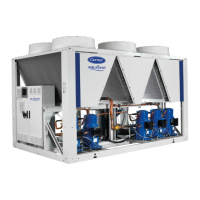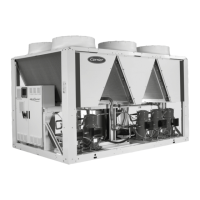32
Refer to the schematic diagram in the "Water connections"
paragraph for all item references in this chapter.
The water circulation pumps of the units in the range have been
sized to allow the hydronic modules to operate in all possible
congurations based on the specic system conditions, i.e. at a
range of temperature differences between the water inlet and
outlet at full load from 3 to 10 K.
This temperature difference required between the water inlet
and outlet determines the nominal ow rate of the system. Use
the specication provided when selecting the unit to determine
the system's operating conditions.
In particular, collect the data to be used for setting the
installation ow rate:
• For a unit without hydronic module: nominal pressure
drop at the unit terminals (plate heat exchanger + internal
water pipe). This is measured with pressure differential
gauges that must be installed at the unit's inlet and outlet
(item 21).
• Units with xed speed pumps: nominal ow rate. The
pressure of the uid is measured by sensors installed at
the inlet of the pump and outlet of the unit (items 7 and
10). The system calculates the ow rate associated with
this differential pressure. The ow rate can be read directly
on the user interface (refer to the control manual for the
range).
• Units with variable speed pumps - control on pressure
differential: pressure differential at the hydronic module
terminals,
• Units with variable speed pumps - control on temperature
difference: nominal temperature delta at the exchanger.
If this information is not available when activating the system,
contact the design ofce responsible for the installation to
obtain it.
This data can be obtained either from the performance tables
included in the technical documentation (for cases where the
water type heat exchanger temperature delta is 5 K) or from
the "Electronic Catalogue" selection program for all other
applicable temperature delta in the range of 3 to 10 K.
General information
The nominal ow rate of the system will be set using a manual
valve that should be installed on the water outlet pipe (item
22 on the water circuit schematic diagram).
Due to the pressure drop it generates on the hydronic network,
this ow control valve is used to set the network pressure/ow
rate curve to the pump pressure/ow rate curve, to obtain the
nominal ow rate at the desired operating point.
This is checked by reading the pressure drop on the unit (plate
heat exchanger + internal piping).
As the exact total system pressure drop is not known upon
commissioning, it is necessary to adjust the water ow rate
with the control valve to obtain the installation's specic ow
rate.
Hydronic circuit cleaning procedure
• Open all control valves completely (item 22).
• Start up the system pump.
• Read the pressure drop of the plate heat exchanger using
the pressure differential gauge to nd the difference
between the unit inlet and outlet (item 21).
• Let the pump run for 2 hours continuously to clean up
the system's hydraulic circuit (presence of contaminating
solids).
• Perform another reading.
• Compare this value to the initial value.
• A reducing value of the ow indicates that the lters on
the system need to be removed and cleaned. In this case,
close the shut-off valves on the water inlet and outlet
(item 19) and remove the lters (items 20 and 1) after
draining the hydronic part of the unit (items 6).
• Remove the air from the circuit (items 5 and 17).
• Repeat until all fouling is removed from the lter.
Water ow rate adjustment procedure
Once the circuit has been decontaminated, read the pressures
on the pressure gauges (water inlet pressure - outlet pressure)
to determine the pressure drop across the unit terminals (plate
heat exchanger + internal pipework).
Compare the value obtained with the design value predicted
by the selection software.
If the pressure drop reading is above the specied value, this
indicates that the ow rate at the terminals of the unit (and
therefore within the system) is too high. In this case, close the
control valve and read the new difference in pressure.
Repeat as necessary, closing the control valve until the specic
pressure drop corresponding to the unit's nominal ow rate
is achieved.
NOTE:
If the network has an excessive pressure drop in relation to
the available static pressure delivered by the system's pump,
the nominal water ow rate cannot be obtained (lower
resulting ow rate) and the temperature difference between
the water inlet and outlet of the water type heat exchanger
will be increased.
To reduce the system's hydronic network pressure drop:
• Reduce the pressure drops of individual components
(bends, level changes, options, etc.) as much as possible;
• Use the correct pipe diameter;
• Do not extend the hydronic systems.

